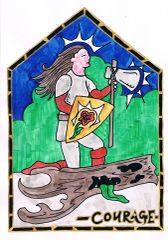Courage
The Path of Courage
Courage is the straightened spine.
It is the strength to stand by one’s convictions.
It is the burning need to do what must be done.
The virtue of Courage is prominent in every part of Imperial life, always present when hardship rears it's head, driving the citizens of the Empire to make their world better. Whatever challenges they must face, the Courageous will always find a way – and defeat is not the end.
Courage is a broad Path, but a rocky one. Whether someone finds herself standing up to a senator’s self-interest, revealing a dangerous secret to the world, or standing firm in the teeth of a thousand howling barbarians, Courage is never easy. It is popular among the Empire’s soldiers, who must face the specter of death more often than most, but it is not solely a martial virtue. The honesty of the Freeborn is often seen as a form of Courage; the horrors that the Varushkan people face on a daily basis would overcome them in an instant if they lacked courage.
A strong theme of the Virtue of Courage is doing what is right rather than what is easy. Many who follow the Path of Courage have a personal code to which they cleave that guides their actions. Some see a refusal to do what they believe to be right as the ultimate treachery against their own souls; “If I know a thing is wrong but lack the Courage to oppose it, I am complicit; if I know a person is wrong but lack the Courage to challenge them, I am their ally.”
Courage thrives when it is challenged; indeed, it requires challenge. The newly-appointed Senator must stand for his people’s interests no matter what any others in the Senate might want; the mystic must tell her thane when he is doing wrong, despite his temper; and of course, each and every soldier in a formation must know that the shield-sibling on their shoulder will stand and fight and die for the good of the Empire. Many priests argue that hardship does not reveal Courage – hardship makes Courage.
Fear, despair and shame are all the enemies of Courage. Fear is born of weakness, fatalism and the belief that defeat and death are inevitable and must be avoided. Despair breeds among those who are unhappy with their lot, but cannot bring themselves to oppose the source of their pain. Shame begins when someone places the opinion of others above doing what is right. A Courageous person does not care what anyone else thinks of them; they know that those who matter will respect their bravery and forthrightness.
In traditional theology, Courage is sometimes called a “structural Virtue”, for it is implied in several of the other Virtues. To face the price of striving for one’s Ambition, for instance, requires Courage; so too do Vigilance and Loyalty, which often require challenging power and authority. Those who follow the Way of Courage sometimes argue that this makes it the most important.Others argue that for most, it is subsumed within the ordinary bravery of following the Way, but it is crucial for those in positions of power, who are often subject to impressive pressures.
Guidance on the Path
Through study of the Paragons and Exemplars, the priests of The Way have gleaned insight into the heart of the Virtue and how best to pursue it. There are collections of parables, tales, sayings and teachings that distill this for Imperial Citizens to learn from. The following are a handful of teachings and sayings deemed to be essential to understanding the Path:
- The Virtuous face unwelcome truths as boldly as any barbarian charge.
- Do not fear to act; only be shamed by inaction.
- Cleave to what you know is true, even where others wish you to doubt.
- Never accept defeat; adapt your strategy and try anew.
- Despise cowardice which steers the spirit to weakness and inaction.
Paragons and Exemplars
Recognised Paragons and Exemplars of Courage include:
- The oldest recorded Paragon, Korl, whose legendary learned the secrets of metal in the darkest places of the world and used them to craft the first axe, with which he drove back the dark forest and slew the beasts who dwelt within.
- The Exemplar Permion of the Highborn who opposed the wicked power of the corrupt Patrician’s Council and empowered the Assembly of the Virtuous in its place.
- The Exemplar Gilda Ashwine of Dawn whose fortitude and commitment freed her family and brought down the corrupt earl who had enslaved them.
- The Exemplar Inga Tarn of Wintermark whose fearlessness and forthrightness inspired generations to sieze the opportunities life presents.
Symbols, icons and trappings
The Path of Courage has many symbols and icons across the Empire, but one of the most common and prevalent is an Axe. This is symbolic of Kord’s creation of both tools and weapons with which to tame the wilderness and overcome obstacles. Several Priests and Pilgrims who walk the Path of Courage carry axes for this reason.
Many who follow a less martial form of courage use the Blue Rose as a symbol, in memory for the influential role it played in Gilda Ashwine’s tale of unwavering resolve.
Some mystically inclined individuals point to the Wintermark rune Jotra, which represents battle and challenges, as a symbol of Courage.
Further Reading
- You can learn about the various spiritual roleplaying effects created by priests dedicated to Courage here.
- You can learn about the skills that priests can use to support the virtue of Couage here.
